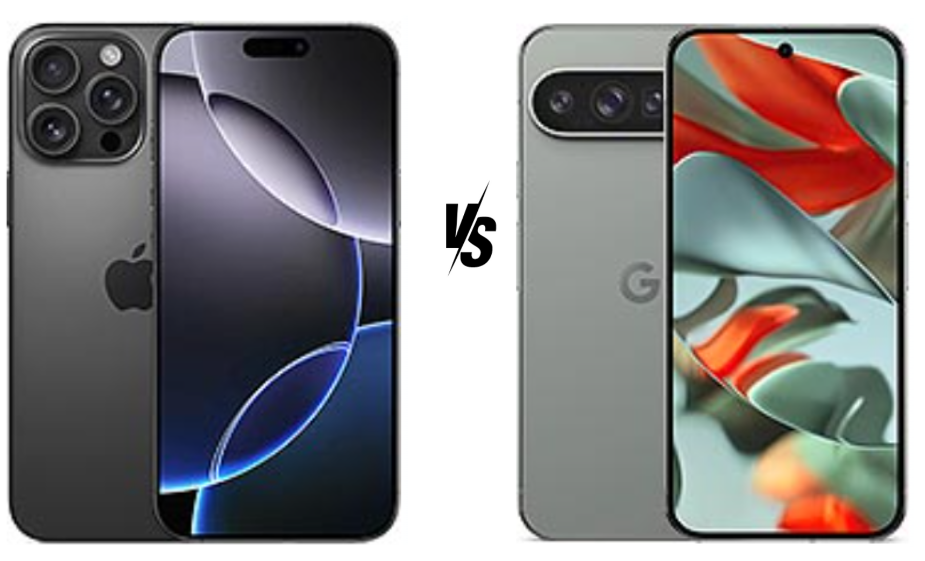iPhone 16 Pro Max and Google Pixel 9 Pro XL represent the pinnacle of smartphone innovation in 2024, with each offering cutting-edge technology and unique capabilities. These flagship devices cater to different user needs, blending sleek design with power-packed performance, advanced cameras, and top-tier software. While Apple focuses on seamless integration and premium craftsmanship, Google leverages its AI expertise and software optimizations.
In this comparison, we’ll break down their design, display, performance, battery life, and cameras to help you decide which phone is better suited for your lifestyle.

Specs at a Glance:
| Feature | iPhone 16 Pro Max | Google Pixel 9 Pro XL | Best Specs |
| Design | Premium titanium frame, IP68 (6m for 30 min) | Aluminum frame, IP68 (1.5m for 30 min) | iPhone 16 Pro Max (More durable titanium frame and higher water resistance) |
| Display | 6.9″ LTPO Super Retina XDR OLED, 2000 nits | 6.8″ LTPO OLED, 3000 nits, higher brightness | Google Pixel 9 Pro XL (Higher peak brightness and slightly better screen-to-body ratio) |
| Performance | A18 Pro (3nm), 6-core GPU, up to 1TB storage | Tensor G4 (4nm), AI-focused, 16GB RAM | iPhone 16 Pro Max (More powerful 3nm chipset, better GPU) |
| Battery | 4685 mAh, wired + wireless charging, MagSafe | 5060 mAh, faster charging, wireless options | Google Pixel 9 Pro XL (Larger battery with faster charging capabilities) |
| Camera | 48MP wide, 12MP periscope, 48MP ultrawide | 50MP wide, 48MP periscope, 48MP ultrawide | Google Pixel 9 Pro XL (Higher resolution selfie and better photo processing) |
Design
Features: The iPhone 16 Pro Max boasts a premium build quality with a glass front and back made from Corning’s glass, complemented by a titanium frame (grade 5). It also offers IP68 dust/water resistance up to 6 meters for 30 minutes, making it highly durable. The design includes a sleek profile and elegant aesthetics, typical of Apple’s craftsmanship.
On the other hand, the Google Pixel 9 Pro XL features a glass front and back, but with Gorilla Glass Victus 2, paired with an aluminum frame. It also holds an IP68 rating but is rated for 1.5 meters for the same duration. The design is modern and simplistic, with a focus on functionality.
Similarities: Both smartphones feature a glass and metal construction, emphasizing premium materials and durability. Additionally, they both support dual SIM options, including eSIM capabilities.
Differences: The main difference lies in the materials used: Apple uses a titanium frame, while Google opts for aluminum. The iPhone offers better water resistance compared to the Pixel. Moreover, the design aesthetics differ significantly, appealing to different user tastes—Apple’s sleek elegance versus Google’s minimalism.
Advantages:
- iPhone 16 Pro Max: More premium materials (titanium) and better water resistance.
- Pixel 9 Pro XL: A simpler, more utilitarian design that many users find appealing.
Which is Better? If you prioritize premium materials and superior durability, the iPhone 16 Pro Max takes the lead. However, if you prefer a minimalist approach, the Pixel 9 Pro XL might be your choice.
Display, Media, and Software
Features: The iPhone 16 Pro Max features a 6.9-inch LTPO Super Retina XDR OLED display with a resolution of 1320 x 2868 pixels. It supports a 120Hz refresh rate, HDR10, and Dolby Vision, with peak brightness reaching 2000 nits. The Always-On display enhances usability for notifications and information without fully waking the device.
Conversely, the Google Pixel 9 Pro XL sports a slightly smaller 6.8-inch LTPO OLED display with a resolution of 1344 x 2992 pixels, also supporting a 120Hz refresh rate and HDR10+. With peak brightness up to 3000 nits, it is designed to deliver vibrant visuals, even in bright outdoor conditions.
Similarities: Both devices offer high-resolution OLED displays with a 120Hz refresh rate, enhancing the user experience with smooth animations and transitions. They also provide Always-On display features for quick access to notifications.
Differences: While both displays are impressive, the Pixel’s peak brightness is superior, making it potentially better for outdoor use. The resolution also slightly favors the Pixel in terms of pixel density. However, Apple’s display technology is often praised for color accuracy and overall vibrancy.
Advantages:
- iPhone 16 Pro Max: Known for color accuracy and consistent performance.
- Pixel 9 Pro XL: Higher peak brightness, making it more usable in bright conditions.
Which is Better? For multimedia consumption, the Google Pixel 9 Pro XL offers an edge with higher peak brightness. However, for overall display quality and user interface fluidity, the iPhone 16 Pro Max remains a strong contender.
Performance and Battery
Features: The iPhone 16 Pro Max is powered by Apple’s A18 Pro chip, built on a 3nm architecture. It features a hexa-core CPU and a 6-core GPU, promising top-tier performance in both processing and graphics. The device comes with storage options starting at 256GB up to 1TB, paired with 8GB of RAM.
In contrast, the Google Pixel 9 Pro XL is equipped with the Google Tensor G4 chipset, which is a 4nm processor. This octa-core CPU, combined with a Mali-G715 MC7 GPU, aims to provide efficient multitasking and gaming experiences. The Pixel also offers generous RAM options, starting at 16GB.
Similarities: Both smartphones feature advanced processors designed to handle demanding applications, gaming, and multitasking efficiently. They come without expandable storage options, relying solely on built-in storage.
Differences: The iPhone’s A18 Pro chip is known for its unmatched performance benchmarks, often outperforming Android counterparts in various tests. The Pixel’s Tensor G4 focuses more on AI-driven tasks, like real-time image processing, which is a significant advantage for photography.
Advantages:
- iPhone 16 Pro Max: Superior raw performance and efficiency.
- Pixel 9 Pro XL: Enhanced AI capabilities for photography and software optimizations.
Which is Better? For gamers and heavy multitaskers, the iPhone 16 Pro Max is the better choice due to its processing power. However, for users who appreciate AI features and photography enhancements, the Pixel 9 Pro XL shines.
Cameras
Features: The iPhone 16 Pro Max features a triple camera setup: a 48 MP wide lens, a 12 MP periscope telephoto lens with 5x optical zoom, and a 48 MP ultrawide lens. Its video capabilities are equally impressive, supporting 4K video recording at various frame rates, ProRes, and Dolby Vision HDR.
The Google Pixel 9 Pro XL, on the other hand, also boasts a triple camera configuration with a 50 MP wide lens, a 48 MP periscope telephoto lens, and a 48 MP ultrawide lens. The Pixel excels in computational photography, offering features like Ultra-HDR, Best Take, and advanced low-light performance.
Similarities: Both smartphones offer advanced camera systems with triple-lens configurations and impressive video capabilities. They both support 4K video recording and provide AI enhancements for photo quality.
Differences: The iPhone’s camera focuses on versatility and high-quality video recording, while the Pixel emphasizes computational photography, particularly in low light and dynamic range. Additionally, the iPhone provides higher resolution in its primary lens.
Advantages:
- iPhone 16 Pro Max: Superior video recording capabilities and versatility.
- Pixel 9 Pro XL: Exceptional photo quality, especially in challenging lighting conditions.
Which is Better? If video recording is a priority, the iPhone 16 Pro Max excels. For photography enthusiasts, particularly those who enjoy low-light shooting, the Pixel 9 Pro XL stands out.
Final Verdict
iPhone 16 Pro Max:
- Shines with its premium titanium design and craftsmanship.
- Offers superior performance with the A18 Pro chipset.
- Excellent video capabilities with advanced 4K and Dolby Vision HDR recording.
- Perfect for users who value brand prestige and the seamless integration of the Apple ecosystem.
- Caters to those who want cutting-edge technology and long-term iOS support.
Google Pixel 9 Pro XL:
- Appeals to photography enthusiasts with its AI-driven, computational photography capabilities.
- Simplified, straightforward user experience with pure Android 14.
- Known for its impressive camera performance, especially in low-light conditions.
- Excels in AI-powered features like Best Take and Zoom Enhance.
- Ideal for users who prefer Android innovations and regular updates with extended support.
Both devices are exceptional in their own right. The iPhone 16 Pro Max is better for users who prioritize performance and video capabilities, while the Google Pixel 9 Pro XL is the ideal choice for those who want advanced photography features and a more user-friendly Android experience. Depending on your specific needs, either smartphone could serve you exceptionally well.

